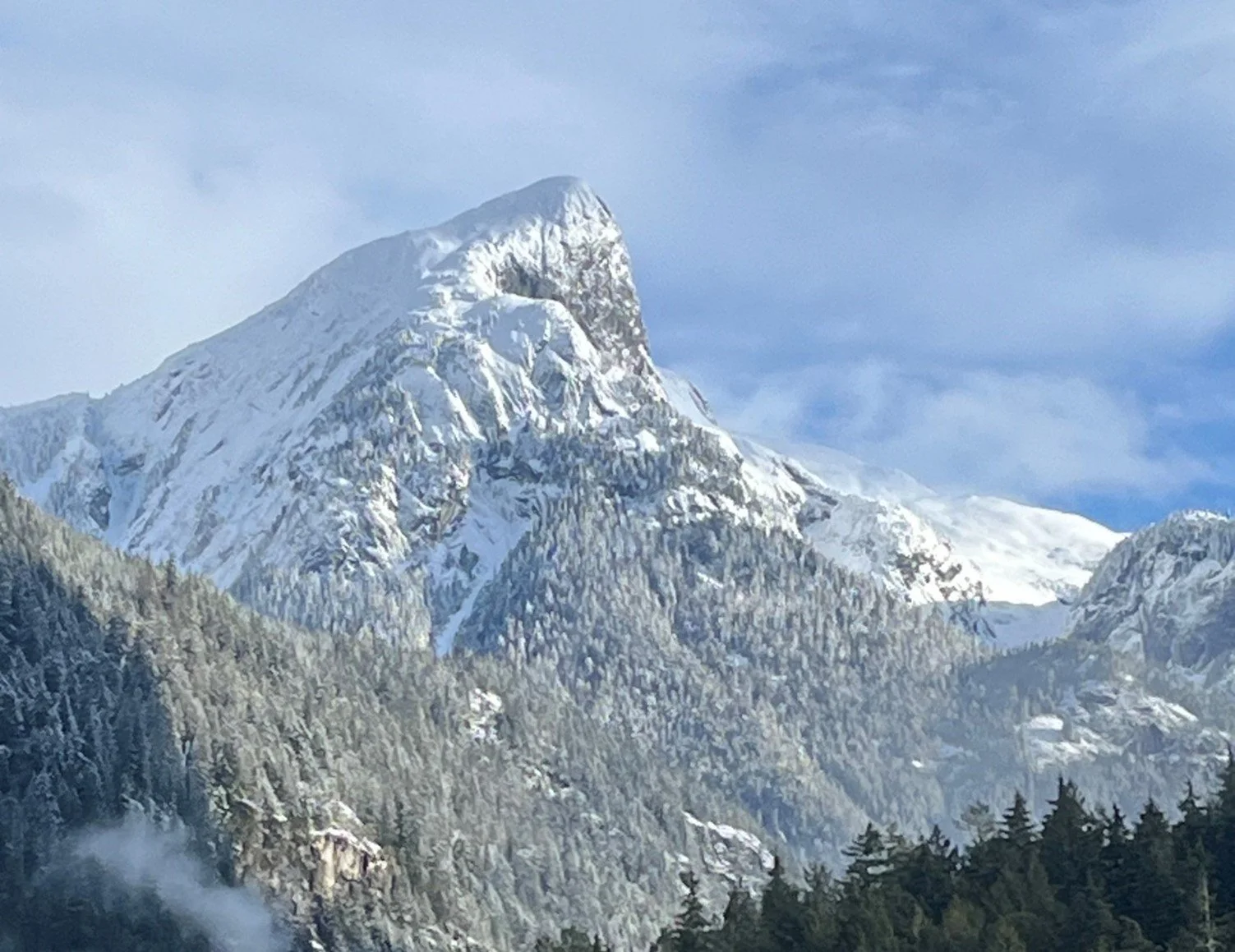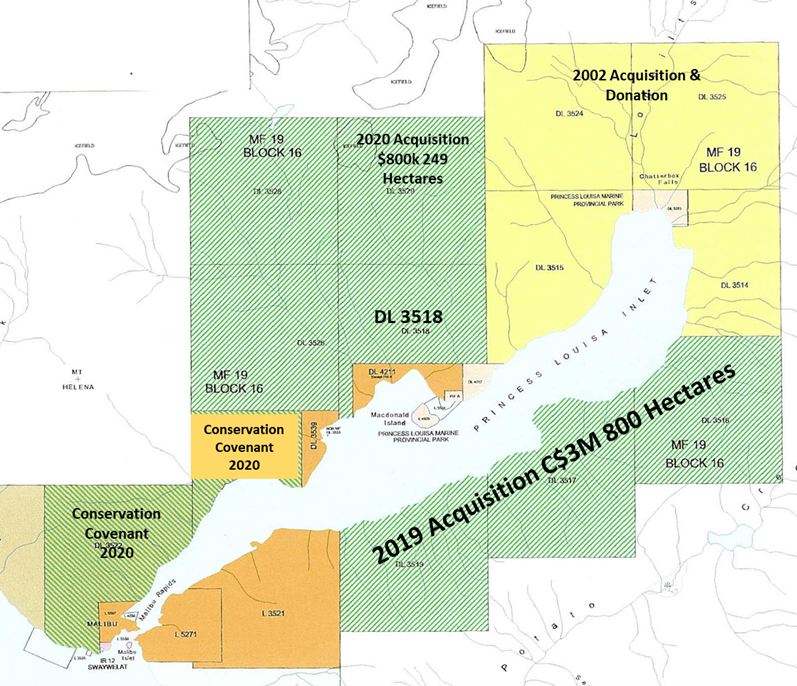The Princess
by Jim Burns, March 2024*
Princess Louisa Inlet is one of the most spectacular fjords in North America. The Inlet is only 70 miles northwest of Vancouver and reachable in minutes by floatplane or an easy one or two days north by boat. However, few living in Vancouver have ever seen it, or even heard of it. Fewer still know that parts of this pristine wilderness area are still at risk from development or logging.
Although much of Princess Louisa is now a Provincial Marine Park, there remain privately owned parcels in the Inlet. Happily, the Princess Louisa International Society, a group of concerned volunteers from both Canada and the US, is committed to spreading the word about this natural treasure and preserving it for future generations.
The Inlet is 4.6 miles long and a half-mile wide and hidden from the world by a narrow winding shaped entrance that is only negotiated safely at slack water. At low or high tide, Malibu Rapids becomes a reversing waterfall of daunting power, best observed from the shore.
Much of Inlet’s walls rise a mile almost straight up out of the water, and it can be 100 feet deep only 10 feet offshore. As such, anchoring in the Inlet can be a challenge.
During the months of May through September the Inlet is one of the most idyllic places on earth; the clear air and crystalline water is unusually still. As you enter you suddenly find yourself deep within unspoiled forestland with waterfalls dropping hundreds of feet from above.
At the head of the Inlet is Chatterbox Falls, a dramatic thunder of glacial water that winds down through the forest. To the left of the Falls is a rock face that rises up 5,200 feet. The rock face contains the James Bruce Falls which, at 2,760 feet, is the tallest waterfall in North America. Those Falls are in turn fed by the Mount Albert glacier. The steep walls of the Inlet make it incredibly difficult to truly capture the majesty of it all in a photograph — you simply have to be there to see it.
An Overlooked Treasure
The Inlet is often called the “Yosemite of the North”, yet Half Dome, the commanding feature in Yosemite, is only 4,700 feet high, thousands of feet short of the peaks that surround Princess Louisa Inlet.
Yosemite was made a state park in 1860, Yellowstone National Park in 1892 and Banff, Canada’s first National Park, was established in 1885.
Even the exacting navigator, Captain Vancouver, missed finding Princess Louisa. In June of 1792 he wrote, “About two leagues from the head of the (Jervis) inlet we observed as we passed upwards, a small creek with some rocky islands before it, where I intended to take up our abode for the night. It was found to be full of salt water, just deep enough to admit our boats against a very rapid stream where at low tide they would have been grounded.” Thus, he described the entrance to the Inlet.
Princess Louisa Inlet continued to be overlooked as a Canadian treasure. It wasn’t until 1964 that the 40-acre parcel that surrounds the Falls was donated by the Princess Louisa International Society to the Province and became the very first Provincial Marine Park in BC.
Additional parcels on the North side of the Inlet, including Macdonald Island, were added to the Park in 1973. The four District Lots surrounding the original Macdonald property were added to the Park in 2003. However, contrary to popular belief the entire Inlet is not all Park.
1800 acres were acquired on the south side of the inlet by the BC Parks Foundation in 2019 and are still owned by the Foundation. Upland parcels including the “One Eye” peak property were acquired and added to the Park in 2020. Conservation Covenants have been registered on several District Lots on the North side and as a result, most of the Inlet is now either Park or at least protected. However there remain properties in the Inlet that are privately owned and still at risk for logging or development. This is described in more detail below.
Mac - A Pioneering Spirit
Among wilderness areas, Princess Louisa’s unique look and ambiance is immediately felt and stimulates the imagination. The first dreamer to be entranced by the inlet was James F. “Mac” Macdonald who in 1919, as a young man, first saw the Inlet on his uncle’s schooner, Rambler.
Although Mac lived off the modest earnings of his family’s grocery business in Seattle, he sought his fortune for 10 years mining near Reno, Nevada. However he always harboured the vivid beauty of Princess Louisa etched in his mind.
With a few thousand dollars in his pocket, Mac filed for a Crown grant of the 40-acre parcel at the head of the Inlet in 1927. The Province advised Macdonald that he could buy the property for $420. and he did. He later bought the island halfway down the Inlet as well.
Having acquired his dream, Mac built an impressive lodge in 1930. He used 60-foot pealed cedar logs 15 to 20 inches in diameter. He bought them for $5 each, delivered. He welcomed yachtsmen, lumbermen, fishermen and adventurers at his dock and built a few trails so they might better enjoy the beauty.
Mac was kind and engaging, loved chess, and was easy to be around. He liked to tell vivid, romanticized stories about the First Nations. He was a flamboyant entertainer much loved for his fire dance using alcohol on parts of his body. In his last public performance at the Inlet’s Malibu Club Resort, he caused the drapery to catch fire.
Visitors returned year after year to stay in the Inlet and spend time with Mac who was as much an attraction as the Inlet itself. As he liked to spend his winters in Mexico or travelling to exotic locations, he found himself a travelling companion and guest of many of his Inlet friends. He was accepted as the unofficial Laird and host in the Inlet. They called him “Princess Louisa Mac”.
In 1941 Mac fell in love and married. While ferrying in his bride to his cabin at Chatterbox Falls, he found his home engulfed in flames. It burned to the ground. The marriage did not last, and he could not afford to rebuild. Nevertheless, Mac persisted with his dream, found a house on a small barge, had it towed into the Inlet and secured it next to the falls where he lived and continued to welcome and entertain visitors.
Hamilton’s Dream
Mac was soon joined by another dreamer, Tom Hamilton, a shrewd, enthusiastic and successful aircraft entrepreneur who claimed to have invented (though he had not) the variable pitch propeller. In 1938, he was told by Bill Boeing when their yachts, Malibu and Taconite, were moored in Campbell River, “You can’t leave until you have seen Princess Louisa Inlet.” The next day both yachts travelled to the Inlet.
Ethyl Hamilton, Tom’s wife, immediately fell in love with the place, particularly the island halfway down the Inlet. Tom told her, “It’s yours” and in 1940 Hamilton persuaded Mac to sell him the island for $18,000. He immediately named it “Hamilton Island”.
Hamilton had decided to build a resort in the Inlet that he would call a “Mecca for Millionaires”. He bought essentially the remainder of the Inlet, including 9,381 acres of the Sechelt Reserve, from the BC Government for $6,000. He soon renamed One Eye, the most dramatic mountain in the Inlet, Mount Hamilton.
Hamilton spent almost a million dollars on the project which is about $20 million in today’s dollars. That did not include uncounted thousands in advertising and promotion. He built the first phase of his resort—a camp that was a secession of log lodges—right at the entrance of the Inlet.
Although the art of the Sechelt Nation was readily available, he decorated the buildings with Indian themes and art of the US Southwest. He commissioned a 60-foot totem pole that depicts faces of his family under a thunderbird and includes an image of the standard Hamilton three-bladed propeller at its base. It can still be seen today.
He named the resort Camp Malibu after his yacht, and in 1947 he added a golf course, barging in soil and turf to cover the granite.
He bought flying boats and a succession of yachts to ferry in celebrities of the 1940s. John Wayne, Bing Crosby, Bob Hope, Fred MacMurry, William Holden, Ann Miller, Alexis Smith, Robert Taylor, Robert Cummings and Conrad Hilton all stayed at Malibu Club. Hamilton photographed himself with all of them. Barbara Stanwick also came but flew out two days later as she tired of Hamilton’s attention.
A Dream Abandoned
The next phase of the resort was to be a Swiss Village behind Hamilton Island. This was to be followed by a tram on cables to convey guests to the glacier above for skiing. The resort ceased operations for the Second World War, but vigorously relaunched in July 1947.
The resort was never very profitable. Though the reasons are not fully understood, Hamilton lost interest and in 1950, abruptly abandoned the resort, taking his staff with him. Food was left in cooking pots and on the dining tables. Rooms filled with spider webs. A large yacht, Chief Malibu, was left tied to the dock with hatches open. It filled with rainwater and sank. For years its mast was exposed at low tide.
Young Life
In March 1953, Jim Reyburn, who had built Christian camps for young people, flew in to look at the abandoned Malibu Club. Before Reyburn got off the plane he declared that Malibu Club would be Young Life’s next camp. Jim’s advisers did not support the plan, thinking the ultimate investment too large.
Hamilton and Reyburn, both men of big dreams, got on well. Hamilton sold the abandoned resort to the Young Life organization for $300,000, taking $50,000 in cash, the rest covered by a note.
Threat of Commercial Development
In 1958, Hamilton sold the remaining land that he owned in the Inlet to lumber giant MacMillan Bloedel. Five years earlier, Mac had been offered $400,000 for his property at the Falls by a hotel chain. He rejected the offer but recognized that protecting the Inlet from commercial exploitation was going to be exceedingly difficult. He talked openly about the challenge with boaters who visited the Inlet.
A plan evolved for an international, non-profit organization to be the owner and protector of the Inlet. Its goal would be the acquisition of additional acreage until all of Princess Louisa Inlet was protected from commercial development.
A Society to the Rescue
In October 1953, the Princess Louisa International Society was created for the express purpose of taking title to Mac’s property and preserving the Inlet. Six Directors were initially elected and began to actively seek donations and memberships, to enable the Society to purchase additional land and to maintain the Inlet and its facilities.
The transfer to the Society contained a clause indicating the intention to eventually turn the land over to the Province of BC as a park. By 1964, the Society was struggling to maintain Mac’s property at the Falls and, with Mac’s blessing, transferred the property to the Province of BC to become the very first Provincial Marine Park in BC.
The Deed of transfer contains a specific provision that the Province must maintain the property as a “Class A Provincial Park” as defined in the Park Act, or else the property reverts to the Society.
In 1972, following the death of Tom Hamilton, his estate sold his beloved island to the Society. The island was subsequently transferred to the Province and added to the Park. B.C. Parks then renamed it Macdonald Island after its previous owner.
Still, most of the land around the Inlet remained owned by MacMillan Bloedel. The company planned to harvest commercial grade timber in the area. With logging imminent, B.C. Parks, with the Society’s encouragement, began a campaign to make the Inlet a National Park in 1973. This initiative was turned down by the Canada National Parks Board.
Another proposal was made within B.C. Parks to offer timber from Garibaldi Park to MacMillan Bloedel in exchange for the timber in Princess Louisa Inlet, but this proposal was rejected in 1979 by the Province.
Fund Raising Progress
In 1996, the Society became a registered charity under the Income Tax Act of Canada. In the same year, through Society President, Martin Crowder of Seattle, the Directors of the Society were able to form the Princess Louisa International Foundation, a US 501(c)(3) non-profit corporation. The Directors of the Society and the Foundation are the same. As a result of these changes, both Canadian and American donors wishing to help preserve the Inlet are able to make a donation and to receive a tax benefit for doing so.
This was critically important because by 1999, Weyerhaeuser, which had acquired all of the Inlet property previously owned by MacMillan Bloedel, was considering disposing of its Canadian assets. As a result, the Society was able to negotiate an Option to Purchase each one of the 13 District Lots then owned by Weyerhaeuser in the Inlet.
The Option was effective in February of 2000 and was registered on the title to each of the District Lots. However, it expired in 2010 and it permitted Weyerhaeuser to undertake limited timber harvesting on the District Lots. Before doing so, it had to review its harvesting plan with the Society and obtain consent. The key element was that Weyerhaeuser had to ensure that the harvesting had “low visual impact” when viewed from the surface of the Inlet.
Subsequently, Weyerhaeuser reviewed its plan with the Society, received reluctant consent, and helicopter logged “patches” of standing timber from the benches far above the south shore of the Inlet. As promised, the logged patches were undetectable from the surface of the Inlet.
However, the actual logging was another matter. A giant Sikorsky Sky Crane operating over the Easter weekend was incredibly disruptive and created a fury of complaints from those in the Inlet at that time – “An Easter in Hell”, one visitor wrote.
Partly as a result, the Society redoubled its efforts to raise the needed funds to purchase the various District Lots. The immediate objective was the four District Lots that surrounded the Falls, comprising about 2,200 acres. These included the entire rock face beside the Falls.
Then President, Bill Botham contacted the Nature Conservancy of Canada and they in turn canvassed a number of well-known family Foundations. Several representatives of the Foundations were flown into the Inlet, given an extensive tour (by sea and air) and asked if they were prepared to contribute.
Of these, only the Tula Foundation was really interested and truly stepped up by donating $1,500,000 to the purchase. The Society contributed $400,000, the Nature Conservancy contributed approximately $1,600,000 (which included the $1.5 million from the Tula Foundation) and Weyerhaeuser donated one of the District Lots under the Ecological Gifting Program.
Without the donation from the Tula Foundation, this purchase absolutely would not have happened. The land was transferred to the Province in March of 2003, with the same provisions as the 1964 transfer of the original 40-acres, and the Park boundaries were greatly increased.
The struggle to protect the Inlet
The acquisition of the four District Lots completely exhausted the funds of the Society and although fundraising efforts continued, “donor fatigue” ensured that the results were modest. With each District Lot having a value (including the standing timber) of about $1 million, further purchases before the Options expired were simply not achievable.
Weyerhaeuser then transferred all of its remaining District Lots to Islands Timberlands LP, a Brascan controlled limited partnership that began to market the Lots in earnest. Fortunately, these Lots were still subject to the Option in favour of the Society and that proved to still have value.
One of the first to take advantage of the new marketing effort was Bob Goff, a former lawyer, a lover of the Inlet and a best-selling author. Bob has rescued young people from human slavery in Uganda and India and built an academy for them called Restore International. He advocates thinking big and acting accordingly. Bob already owned the property next to Malibu on the outside of the Inlet and purchased a number the District Lots on the North shore of the Inlet.
As these District Lots were still subject to the Option, a release by the Society of the Option had to be obtained before the sale could be completed. The Society’s terms for doing so were simple, a Conservation Covenant limiting development of the property had to be registered against title. Bob Goff happily agreed to this as his interests were coincident with those of the Society, the preservation of the Inlet.
Another purchaser of a District Lot was an organization called the Global Conservation Mountain Biking Club, which appears to be controlled by a New Zealand family. When the Society learned that the mountain bikers would come into the Inlet by helicopter, this raised serious concerns.
By this time however, the Society’s Option had expired, and it was not able to ensure that a Conservation Covenant was placed on the property. To their credit, a team of New Zealand trail builders sensitively constructed a series of mountain bike trails that cannot be seen from the Inlet.
The Biking Club has constructed one wooden float on the water in the Inlet that is quite unobtrusive and the land, for the most part, is conserved in its natural state. There have been no visits by helicopter, just simply by boat. Nevertheless, this District Lot remains the only one on the North shore of the Inlet with no restrictions on development.
Cooperation with BC Parks
For many years, the Society had an informal arrangement with BC Parks that involved annual consultations on issues such as Park maintenance and Ranger staffing. However, with Provincial budget cuts, the capacity of BC Parks to continue to staff the Inlet with a Ranger during the period from May to September each year came into question.
The Directors of the Society were very anxious to ensure the presence of a Ranger in the Inlet. As a result, in May of 2014, the Society entered into a Donation and Cooperation Agreement with BC Parks. This Agreement formalized the consultation process and provided for an annual donation of funds by the Society to BC Parks to assist with the expense of maintaining and staffing the Park.
The Agreement has been renewed every year since with increasing levels of funding. The Society has also stood ready to assist in funding any needed maintenance issues in the Park. The most recent example being the re-roofing of the McDonald Shelter and the installation of mooring buoys.
The Push to Complete Conservation of the Inlet
Once the purchase of the District Lot by the New Zealand Biking Club was completed, the entire North shore of the Inlet was either owned by Young Life, Bob Goff, the New Zealand Club or was part of the Park.
However, there remained the challenge of the south shore District Lots, three of which three were still owned by Island Timberlands and actively for sale. The Society did not have sufficient funds to purchase even one of the District Lots and this time it was the BC Parks Foundation who stepped into the breach.
In May of 2019, they successfully negotiated a purchase price of $3 million for the three south shore District Lots. With the completion date set for August 28, 2019, fund raising began in earnest. BC Parks Foundation received a number of large donations and the Society contributed $175,000 to the purchase which, once again, substantially depleted its resources.
As a result of great work by the BC Parks Foundation, their fund-raising efforts were picked up by international media including the New York Times. As a result, the majority of the purchase price was raised by “crowd funding” with donations coming from as far away as Germany and Japan.
It was quite wonderful to see the community involvement in the effort, including Elementary School fund raisers. Most donors had never even heard of the Inlet before, let alone visited it. Happily, all these efforts were successful, and the purchase was completed as scheduled.
The three south shore District Lots remain in the name of the BC Parks Foundation pending completion of a comprehensive agreement with BC Parks for their inclusion as part of the Princess Louisa Marine Park.
The most recent acquisition was the District Lot to the West of the rock face that includes the “One Eye” peak. Once again, the combined efforts of the BC Parks Foundation, the Goff family and the Society were able to raise the $800,000 needed to complete the purchase and to add this District Lot to the Park. Also, the Goff family and Young Life agreed to register a Conservation Covenant on their own holdings in the Inlet.
Swiwelat
No discussion of the history of the Inlet would be complete without reminding us that the Inlet has been considered to be a sacred place by first nations for millennia. “Swiwelat” is the name by which the Inlet is called by the Shíshálh first nation which has designated the Inlet as a Cultural Emphasis Area.
It is described as: “a landscape of extremely high special and unique spiritual importance to the Shíshálh Nation, characterized by dramatic vertical relief from sea to mountain levels including a sacred place, long recognized for its overwhelming beauty, mystical nature and spiritual character, preferred internment site, site of the mythical water horse as well as high wildlife and biodiversity values”.
While it appears to be the case that preservation of the Inlet is an objective shared by both the Society and the Shíshálh Nation, it remains for an agreement to be reached as to how best to achieve this objective.
The Current State of the Inlet
Mac’s stated desire was to keep the Inlet “just the way it is” but he could not have imagined the way its modern history would unfold.
Visitations to the Inlet in recent years, post COVID, have increased quite dramatically and we need to take care to ensure that the Princess is not spoiled by overuse.
The Princess Louisa International Society, with its equal number of Canadian and American Directors, remains absolutely committed to maintaining its pledge to Mac that it would preserve the Inlet “just the way it is” for the benefit of generations to come.
(Editor’s note: Jim Burns, is a Princess Louisa International Society Director Emeritus, and former Board President. Over the last 30+ years he has been dedicated to the preservation of the Park, and has been instrumental in several landmark land acquisition programs and addition of conservation covenants in the Park.)
*Bibliography credits: 1) The Princess, John Henry Painter, Pacific Yachting Magazine, August 2014, 2) The Curve of Time, M. Wylie Blanchet, Seal Publishing, January 1, 1961, 3) Mac and the Princess – the Story of Princess Louisa Inlet, Bruce Calhoun, Ricwalt Publishing, January 1, 1976, 4) Beyond Understanding – the Complete Guide to Princess Louisa, Chatterbox Falls, Wm H. Schweizer, Eos Publishing, 1989, 5) Through the Rapids – The History of Princess Louisa Inlet. Charles W. Hitz, Sitka2 Publishing, 2003.





